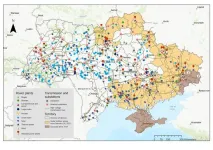(Press-News.org) Some of the greatest discoveries don’t come merely from observations but from thinking. Einstein developed theories about relativity through thought experiments, and Galileo derived insights about gravity through mental simulations. A review published September 18 in the journal Trends in Cognitive Sciences shows that this process of thinking is not exclusive to humans. Artificial intelligence, too, is capable of self-correction and arriving at new conclusions through “learning by thinking.”
“There are some recent demonstrations of what looks like learning by thinking in AI, particularly in large language models,” says author Tania Lombrozo, a professor of psychology and co-director of the Natural and Artificial Minds initiative at Princeton University. “Sometimes ChatGPT will correct itself without being explicitly told. That’s similar to what happens when people are engaged in learning by thinking.”
Lombrozo identified four examples of learning by thinking in humans and AI: learners can acquire new information without external input through explanation, simulation, analogy, and reasoning. In humans, explaining how a microwave works to a child might reveal the gaps in our understanding. Rearranging furniture in the living room often involves creating a mental image to simulate different layouts before making any physical changes. Downloading pirated software may initially seem morally acceptable until one draws an analogy to the theft of physical goods. If you know that a friend’s birthday is on a leap day and tomorrow is a leap day, you can reason that your friend’s birthday is tomorrow.
AI shows similar learning processes. When asked to elaborate on a complex topic, AI may correct or refine its initial response based on the explanation it provides. The gaming industry uses simulation engines to approximate real-world outcomes, and models can use the outputs of simulations as inputs to learning. Asking a language model to draw analogies can lead it to answer questions more accurately than it would with simple questions. Prompting AI to engage in step-by-step reasoning can lead it to answers it would fail to reach with a direct query.
“This poses the question of why both natural and artificial minds have these characteristics. What function does learning by thinking serve? Why is it valuable?” says Lombrozo. “I argue that learning by thinking is a kind of ‘on-demand learning.’”
When you learn something new, you don’t know how the information may serve you in the future. Lombrozo says people can squirrel away the knowledge for later—until the context makes it relevant and worthwhile to expend the cognitive effort to think and learn.
Lombrozo acknowledges the challenges in defining the boundaries between reasoning, learning, and other high-level cognitive functions, which is an area of debate within the field of cognitive sciences. The review also raises more questions, some of which Lombrozo plans to explore further, such as whether AI systems are actually “thinking” or simply mimicking the outputs of such processes.
“AI has gotten to the point where it’s so sophisticated in some ways, but limited in others, that we have this opportunity to study the similarities and differences between human and artificial intelligence,” says Lombrozo. “We can learn important things about human cognition through AI and improve AI by comparing it to natural minds. It’s a pivotal moment where we’re in this new position to ask these interesting, comparative questions.”
###
Trends in Cognitive Sciences, Lombrozo, “Learning by thinking in natural and artificial minds” https://www.cell.com/trends/cognitive-sciences/fulltext/S1364-6613(24)00191-8 DOI: 10.1016/j.tics.2024.07.007
Trends in Cognitive Sciences (@TrendsCognSci), published by Cell Press, is a monthly review journal that brings together research in psychology, artificial intelligence, linguistics, philosophy, computer science, and neuroscience. It provides a platform for the interaction of these disciplines and the evolution of cognitive science as an independent field of study. Visit http://www.cell.com/trends/cognitive-sciences. To receive Cell Press media alerts, please contact press@cell.com.
END
In an opinion article publishing September 18 in the Cell Press journal Trends in Molecular Medicine, physician-scientists argue that with most placentas discarded after birth, placental pathology is underutilized clinically, should be a routine part of obstetric and neonatal care, and also deserves more research attention.
“Placentas should not be considered a waste tissue,” says senior author Mana Parast, MD, PhD, professor of pathology at University of California San Diego School of Medicine. ...
Drug overdose mortality has risen faster among adolescents than the general population in recent years, largely due to fentanyl, a potent opioid pain medication. A new study published in JAMA sheds light on trends in nonfatal opioid overdoses in youth – an area that was not as well characterized, but key to formulating prevention strategies to save lives.
Researchers from Ann & Robert H. Lurie Children’s Hospital of Chicago and colleagues analyzed data using Emergency Medical Services (EMS) encounters from January 2018 to December 2022. They found that opioid overdoses in youth increased at pandemic onset and remained elevated compared to pre-pandemic levels. The majority ...
About The Study: Prehospital encounters for youth opioid overdoses were increasing prior to the pandemic, increased with the onset, and then stabilized, remaining higher than pre-pandemic levels. Although overall patterns were largely driven by those ages 18 through 24, adolescents ages 12 through 17 were the only subgroup with an increasing number of encounters both before and during the pandemic.
Corresponding Author: To contact the corresponding author, Jamie Lim, MD, email jlim@luriechildrens.org.
To access the embargoed study: Visit our ...
** Caltech is hosting an embargoed media zoom about this result on Monday, September 16 at 10am Pacific/1pm Eastern. You can register here:
https://caltech.zoom.us/webinar/register/WN_gYEV5Tl1S0uZkZG1gDIEnQ#/registration
Astronomers have spotted the biggest pair of black hole jets ever seen, spanning 23 million light-years in total length. That's equivalent to lining up 140 Milky Way galaxies back to back.
"This pair is not just the size of a solar system, or a Milky Way; we are talking about 140 Milky Way diameters in total," says Martijn ...
About The Study: In this study, the overall survival of the face transplants is encouraging. These data suggest that the acceptable long-term survival of face transplants makes them a reconstructive option for extensive facial defects.
Quote from corresponding author Pauliina Homsy, MD, PhD:
“A total of 50 face transplants have been performed since 2005. Activity has been concentrated with only 18 centers in 11 countries giving this treatment. Our study demonstrates an overall 5- and 10-year survival of face transplants ...
About The Study: In this cohort study of 1.5 million patients seeking preventive care, denials of insurance claims for preventive care were disproportionately more common among at-risk patient populations. This administrative burden potentially perpetuates inequitable access to high-value health care.
Corresponding Author: To contact the corresponding author, Alex Hoagland, PhD, email alexander.hoagland@utoronto.ca.
To access the embargoed study: Visit our For The Media website at this link https://media.jamanetwork.com/
(doi:10.1001/jamanetworkopen.2024.33316)
Editor’s ...
About The Study: The results of this randomized clinical trial showed that transitioning insomnia care for older adults away from long-term sedative use and toward cognitive behavioral therapy for insomnia can be achieved using a mailed, direct-to-patient approach.
Corresponding Author: To contact the corresponding author, David M. Gardner, PharmD, MSc CH&E, email david.gardner@dal.ca.
To access the embargoed study: Visit our For The Media website at this link https://media.jamanetwork.com/
(10.1001/jamapsychiatry.2024.2731)
Editor’s ...
Risk calculators are used to evaluate disease risk for millions of patients, making their accuracy crucial. But when national models are adapted for local populations, they often deteriorate, losing accuracy and interpretability. Investigators from Brigham and Women’s Hospital, a founding member of the Mass General Brigham healthcare system, used advanced machine learning to increase the accuracy of a national cardiovascular risk calculator while preserving its interpretability and original risk associations. Their results showed higher accuracy overall in an electronic health records cohort ...
One of the main targets of Russia’s ongoing attacks on Ukraine is the energy infrastructure. The extent of the destruction is enormous. “One year after the start of the war in February 2022, 76 percent of thermal power plants had been destroyed; now the figure is 95 percent,” says Ukrainian scientist Iryna Doronina. “And all the large hydroelectric power plants have also failed.” The breaching of the Kakhovka dam proved to be particularly devastating. The huge outflow of water – the reservoir ...
Media Contact: laura.kurtzman@ucsf.edu, (415) 502-6397
Subscribe to UCSF News
After a spinal cord injury, nearby cells quickly rush to action, forming protective scar tissue around the damaged area to stabilize and protect it. But over time, too much scarring can prevent nerves from regenerating, impeding the healing process and leading to permanent nerve damage, loss of sensation or paralysis.
Now, UC San Francisco researchers have discovered how a rarely studied cell type controls the formation of scar tissue in spinal cord injuries. Activating ...

